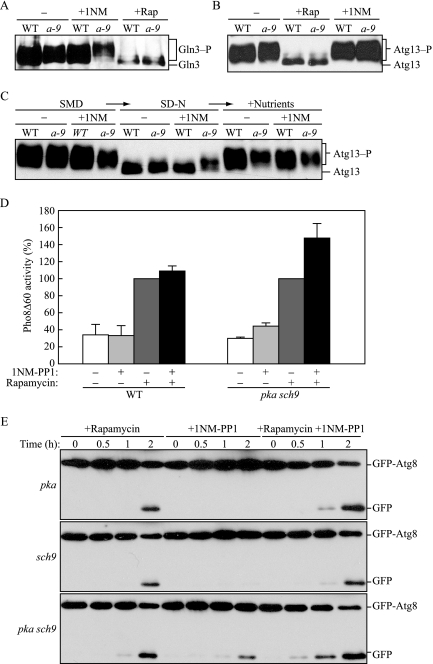Figure 4.
Tor kinase acts in parallel with PKA and Sch9. (A) Gln3 is phosphorylated when PKA and Sch9 are inactivated. Wild-type (TYY201), and pka sch9 (a-9; TYY202) cells expressing Gln3-myc were grown for 2 h in SMD with or without rapamycin or 1NM-PP1. TCA-precipitated proteins were subjected to immunoblotting with anti-myc antibody, as described in Figure 1. (B) Inactivation of PKA and Sch9 does not induce dephosphorylation of Atg13. Wild-type (W303-1B) and pka sch9 (a-9; Y3528) cells harboring a plasmid containing ATG13 (YEp351[APG13]) were grown for 2 h in SMD with or without rapamycin or 1NM-PP1. TCA-precipitated proteins were subjected to immunoblotting with anti-Atg13 antiserum, as described in A. (C) Inactivation of PKA and Sch9 partially affects dephosphorylation of Atg13 that occurs in −N conditions. Wild-type and pka sch9 (a-9) cells harboring the Atg13 plasmid were grown for 2 h in SMD with or without 1NM-PP1, shifted to SD-N for 30 min, and then YNB, amino acids, and vitamins were added to cultures to the same concentrations as those in SMD. At each time point, TCA-precipitated proteins were subjected to immunoblotting, as described in B. (D) Nonspecific autophagy is elevated with inactivation of both the Tor and PKA-Sch9 signaling pathways. Wild-type (TYY172) and pka sch9 (TYY174) cells expressing Pho8Δ60 were grown for 4 h in SMD with or without either or both rapamycin and 1NM-PP1 as indicated. The Pho8Δ60 activity was measured as described in Materials and Methods, and it was normalized to the activity of the cells treated with rapamycin, which was set at 100%. Error bars indicate the SD of at least three independent experiments. (E) pka sch9 (Y3528) cells expressing GFP-Atg8 grown at early log phase were incubated in SMD containing rapamycin and/or 1NM-PP1. At the indicated times, TCA-precipitated proteins were subjected to immunoblotting, as described in Figure 1.

